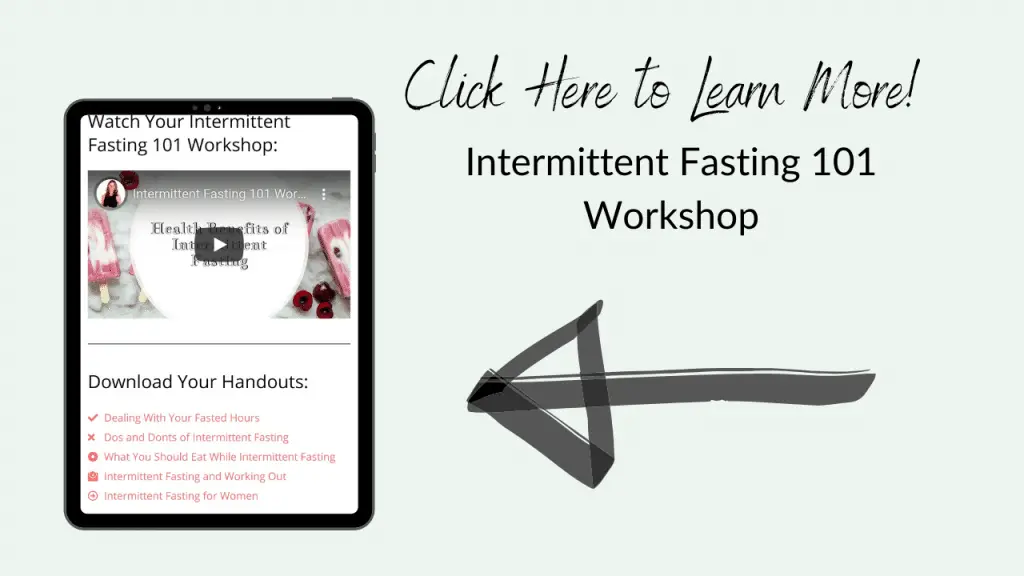If you have been following me for any length of time, you know that the Warrior Diet (or the 20:4 method) is one of my preferred intermittent fasting methods. In today’s post, we dive into how fasting for 20 hours benefits you and into how you can make sure you are choosing the right intermittent fasting method for your body.
Fasting for 20 Hours Benefits
What are the benefits of fasting for 20 hours? Well, let’s look at what happens in your body when you fast for longer than say, 16 hours.

What Happens During a 20-Hour Fast
From about 12 hours to around 28 hours, your body gradually switches from glucose to ketones for energy. Consequently, within, that timeframe, some metabolic changes occur that will benefit you over time.
Ketone Production Increases
It turns out that according to this article in the Annual Review of Nutrition, your body burns more fat than glucose after around 16 hours of fasting. I experienced a metabolic switch around the 16-hour mark (usually when my ketones are measured at 1.0 mmol/L on a ketone monitor). Keep in mind that this happens easier and faster if you have been in ketosis before.
Would you like to check your ketones with a ketone monitor? Get a 15 percent discount on the Keto Mojo with my affiliate link.

Insulin Production Decreases
Lower levels of insulin improve your health and longevity. A decrease in insulin will increase ketone production.
Autophagy
Most studies regarding autophagy start at the 24-hour mark of fasting. We don’t really know that fasting for 20 hours rather than 16 hours will increase autophagy. We do know that MTOR blocks autophagy, and insulin is the main MTOR trigger.
You may enjoy reading What Is Autophagy and How to Induce It.
Increased Fat Loss
As you get deeper into a fast, your body is likely to use more fat to produce energy (in the form of ketones). Moreover, the shorter your eating window, the harder it becomes to eat too many calories.
Better Sleep and Energy Level
These two benefits go hand in hand, of course. As a perimenopausal woman, I have noticed that fasting improves my sleep. When I was losing weight, fasting for 20 hours five days a week was enough to enjoy excellent sleep. My sleep suffered when I stopped fasting regularly after reaching my goal weight, so I started incorporating 24-hour fasts into my health regimen (read Why You Should Try a 24-Hour Fast While and After Losing Weight for more info).
Fewer Food Cravings
As you improve your insulin sensitivity (as a result of decreased insulin production), you will notice that your food cravings decrease as well. Not only that, but if your body functions on ketones regularly, this also reduces your appetite. We don’t exactly know how ketosis decreases appetite. One theory is that it is due to a decrease in the hormone adiponectin.

How to Break a 20-Hour Fast
Following the 20:4 intermittent fasting protocol is pretty straightforward: fasting for 20 hours and eating for hours. However, there are some things to keep in mind. For example, I don’t recommend you fast every day. Five days a week is enough. Moreover, you are allowed some beverages (even some calories) during your fasting time.
What You Can Have During Your Fasting Window
Everyone is unique, and some women may need to stick to no-calorie drinks. It’s a good idea to experiment and see what works best for you. My main issue is that I hate black coffee, and I really wanted to drink coffee during my fasting window. Fortunately, I discovered I could add full-fat coconut milk and MTC oil to my coffee without impacting my ketones and glucose levels (I confirmed this using a ketone monitor). Read How To Make Sure You Can Drink Coffee When Intermittent Fasting to learn more.
Other than that, you can drink:
- Water
- Black coffee or tea
- Herbal tea
- Lemon or apple cider vinegar water
- Carbonated water
You can also use flavored stevia or plain stevia in your drinks

Is a 20-Hour Fast Long Enough?
I mentioned already that the benefits of fasting for 20 hours will keep increasing up to about 28 hours when your body functions fully on ketones. Now, I like the 20-hour window because it is doable. However, some people may not be able to feel the metabolic switch when fasting for only 20 hours. You may notice that it takes you longer. That’s why picking the right intermittent fasting window is crucial.
Picking Your Intermittent Fasting Method
So, how do you pick the right intermittent fasting window, then? It will depend on whether your goal is to lose weight or whether you are simply looking to achieve some of the health benefits (like more energy, fewer food cravings, and better sleep).
Intermittent Fasting for Weight Loss
If your goal is to lose weight, achieving optimal weight loss ketosis and staying there for 2-3 hours is particularly important. Fast long enough to feel the metabolic switch where your hunger doesn’t bother you the same way and where you feel energetic and focused. For many women, this will mean about 16-18 hours; fasting for 20 hours will enable you to maintain that just enough.
Would you like to learn more about using intermittent fasting for weight loss? Don’t forget to check out my Intermittent Fasting 101 Workshop.

Intermittent Fasting for Health
If your intermittent fasting goal isn’t weight loss, you will most likely find that fasting longer than 20 hours but less frequently (like only once a week or less) does the trick. In that case, the goal is to continuously monitor how you feel and experiment with fasting accordingly. For example, if you are not sleeping well. Try a 24-hour fast. See if it helps. If your cravings are coming back, fast for 20 hours one day, and see if that helps. Either way, you will find that your fasting window will still have to be long enough for you to feel the switch. The only difference is that you will not be fasting as often. You will notice that the benefits can carry on for weeks before you need another fast.
Fasting for 20 Hours Benefits Video
In Summary
Fasting for 20 hours benefits you because it is a fairly long fast that is likely to induce a metabolic switchover that is sufficient to notice a difference in how it makes you feel. Furthermore, it is beneficial because while it brings about great fat burning, it is still short enough to be manageable even for less experienced. The 20:4 method has become the number one method I recommend. However, I have found that some women do better with longer but less frequent fasts (24 hours and up only two days a week).






